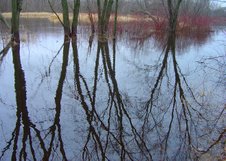Staples World, April 19, 2007
By Tom Crawford
News Editor
Researchers don’t know exactly what they are dealing with at the recently discovered Walker artifact find, but they know it’s something very interesting, according to one of the researchers involved.
Mathew Mattson, one of the researchers involved in the Leech Lake Heritage Program on the Leech Lake Reservation, told an audience of over 70 people gathered Sunday at Wahoo Valley that they are looking at something 13,000 or more years old.
“The Walker find is guaranteed to be controversial because of its age,” Mattson said, as the conventional wisdom is that the first native Americans arrived here roughly 10,000 years ago. The finding of some flint points at a dig just south of the city of Walker in the past three years, if authenticated, could push that date back perhaps 5,000 years - much earlier than most archeologists and paleontologists have thought in the past.The items found are all stone and consequently cannot be dated accurately by carbon dating methods used and accepted by researchers. So their finds are subject to questioning.
“We don’t have a smoking gun,” Mattson said, meaning hard evidence of the time period.
Ideally, he added, joking with his audience, he and fellow heritage site researchers will have to find a hand clutching one of their stone points with a date stamped on the hand. Even that may not be enough evidence to convince some people in academic circles who have questioned the items found in the past three years.
“We don’t have a classic projectile point,” Mattson said, speaking at the annual meeting of the Old Wadena Society. He described how the ‘dig’ at Walker began in 2004 merely to determine if there was any evidence of an early culture at that point, prior to plans to develop roads and a housing project. They first dug in a depression in the ground, thinking it might be a cellar from some early settlers’s shanty. Instead, Mattson said, “It turned out to be an old kids fort, probably built in the 1950’s or 60’s.”
To be sure, they excavated another meter below that level. Shortly before they planned to stop, they found a flake or chip off a larger stone. They immediately felt it was similar to flakes made by early man trying to make a sharp point for a spear.
“Ooops, this doesn’t belong here,” Mattson said.
Six more units or excavations were conducted in 2005, with researchers opening up 33 units in 2006. Altogether, they recovered about 90 artifacts they are now studying, mostly hammer stones and flakes. “We moved 82 tons of dirt, all with a shovel and trowel. And we screened every bit of it,” he added.
Unfortunately, from his point of view, the press got ahold of the story via a leaked memo and the scientific community has split over the find. Too many conclusions have been drawn before researchers have been able to do a complete analysis of what they have found, he said.
“We don’t know exactly what it is, but feel its very interesting. We have something going on here,” he said.
Following his talk, Dr. Duane Lund was presented with the 2007 Founders Award from the Old Wadena Society. Lund, whose books include several references to the Old Wadena site and other historical points along the Crow Wing River, received a plaque and a Pendleton blanket.
Dr. Lund, in thanking the group, said in the 1960’s he attempted to interest Minnesota Historical Society authorities in the Old Wadena location but had little success. Later, as a member of the Concordia College board of directors, Dr. Charles Mayo II viewed Old Wadena when they were looking for a site for the Concordia language camps. While rejecting the Crow Wing River site in favor of lakeshore locations, Dr. Mayo felt Old Wadena had historical interest and was instrumental in getting MHS people to at least look at historical aspects of the first white settlement in Wadena County.
The Old Wadena Society members attending the annual meeting, a group formerly known as the Wadena Historic and Environmental Learning Project (WHELP), officially approved the name change as recommended by the board of directors.
The group’s membership also approved their annual financial statement, approved a new articles of incorporation with the name change and elected a 12-member board of directors.
The board includes John Crandall from Wadena, Mary Harrison from Sebeka, Greg Leifermann and Tom Crawford from Motley and from Staples, Ruth Chapman, Don Droubie, Tom Kajer, Myra King, Russ Lee, Lloyd Nelson and Mel Weins. Dave Mattila from Sebeka volunteered to fill an open spot on the board.
Leifermann is the president and Harrison the vice president.
Those attending included members of the Todd and Wadena County Historical societies as well as the Verndale Historical Society
The Old Wadena Society annually sponsors the Old Wadena Rendezvous and Folk Music Festival, this year on August 10, 11 and 12.


1 comment:
Thanks, Tom, for the good story.
Post a Comment